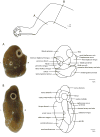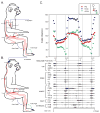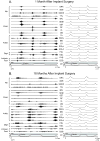Methods for chronic recording of EMG activity from large numbers of hindlimb muscles in awake rhesus macaques
- PMID: 20346976
- PMCID: PMC2878855
- DOI: 10.1016/j.jneumeth.2010.03.011
Methods for chronic recording of EMG activity from large numbers of hindlimb muscles in awake rhesus macaques
Abstract
Studies of the neural control of movement often rely on the ability to record EMG activity during natural behavioral tasks over long periods of time. Increasing the number of recorded muscles and the time over which recordings are made allows more rigorous answers to many questions related to the descending control of motor output. Chronic recording of EMG activity from multiple hindlimb muscles has been reported in the cat but few studies have been done in non-human primates. This paper describes two chronic EMG implant methods that are minimally invasive, relatively non-traumatic and capable of recording from large numbers of hindlimb muscles simultaneously for periods of many months to years.
Copyright (c) 2010 Elsevier B.V. All rights reserved.
Figures





References
-
- Belhaj-Saïf A, Fourment A, Maton B. Adaptation of the precentral cortical command to elbow muscle fatigue. Exp Brain Res. 1996;111:405–16. - PubMed
-
- Bretzner F, Drew T. Contribution of the motor cortex to the structure and the timing of hindlimb locomotion in the cat: a microstimulation study. J Neurophysiol. 2005;94:657–72. - PubMed
-
- Courtine G, Roy RR, Hodgson J, McKay H, Raven J, Zhong H, Yang H, Tuszynski MH, Edgerton VR. Kinematic and EMG determinants in quadrupedal locomotion of a non-human primate (Rhesus) J Neurophysiol. 2005;93:3127–45. - PubMed
-
- Drew T. Motor cortical cell discharge during voluntary gait modification. Brain Res. 1988;457:181–7. - PubMed
-
- Fetz EE, Cheney PD. Postspike facilitation of forelimb muscle activity by primate corticomotoneuronal cells. J Neurophysiol. 1980;44:751–72. - PubMed
Publication types
MeSH terms
Grants and funding
LinkOut - more resources
Full Text Sources
Miscellaneous

